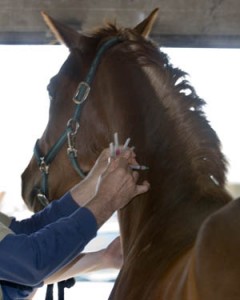It’s spring at last?and time to schedule spring shots. You may be planning to ask your veterinarian to give your horse all his vaccinations on the same visit, along with his annual checkup and Coggins test. It’s convenient, and you’ll pay for only one barn call.

But before making the appointment, consider the question of timing. Timing vaccines correctly?even spreading them out over several visits?can ensure that you get the most bang from your vaccination buck. Here’s why you should time your horse’s vaccinations.
Maximize Protection
Ideally, you should time your horse’s vaccinations to provide optimal protection against the disease?and the best time isn’t the same for all. Vaccines for some diseases, such as tetanus and rabies, can be given at any time of year. But for others the way you time your horse’s vaccinations depends on various factors?the disease and how it spreads, the region of the country where you live, and whether your horse stays home in a closed herd or goes to shows (or has contact with show horses) and is thus more likely to be exposed.
For example, the risk of respiratory diseases that spread horse-to-horse, such as strangles, may jump when a horse moves from a private barn to a boarding stable with an indoor arena. Try to time vaccinations against those diseases to protect him then or at other times when he’ll be at risk. The risks of diseases transmitted by insects?such as Eastern and Western equine encephalitis, West Nile virus, and Potomac horse fever?are greatest when these insects abound. In northern areas, schedule vaccinations against these diseases just before insect numbers surge in spring. The vaccines may need to be administered more frequently in the south.
In general, you want to give the vaccine at least three weeks before the risk to give your horse’s immune system time to respond and build up defenses against the disease. Remember, though, that if your horse has never had a vaccination against a particular disease, your veterinarian may need to give an initial vaccine followed by a booster three to four weeks later to get full protection (this varies among vaccines). In this case, you need to schedule the initial vaccine even sooner before the anticipated exposure.
The type of vaccine used makes a difference in some cases. When using a killed vaccine against West Nile virus, for example, I generally delay boostering until about three weeks before mosquitoes typically hatch (late April here in Minnesota) to ensure peak immunity during the high-risk months of June, July and August. In a horse previously unvaccinated against WNV, I would want to start my series of two shots sooner. Data on one new WNV vaccine suggests strong immunity is still present a year after vaccination. If using that, I would not be as concerned about the timing.
Minimize Problems
Careful scheduling also can help you avoid some problems associated with vaccination. For one, every vaccine has the potential to cause an adverse reaction. If multiple vaccines are given on the same visit and your horse has an adverse reaction, you and your veterinarian may not be able to figure out which vaccine produced it. This is important in making decisions about future vaccines for your horse.
Consider a separate visit for the intranasal vaccine against strangles (a disease caused by Streptococcus equi bacteria), which is sprayed up the nose rather than injected into muscle. When this intranasal vaccine is administered at the same time as intramuscular vaccines, there’s a risk that the vaccine strain of Strep equi may enter injection sites and cause abscesses in a very small percentage of horses. This has led many veterinarians to schedule it on a separate visit. The intranasal strangles vaccine should be given with other vaccines only if your veterinarian is very careful to give it after all of the intramuscular shots and if you are willing to accept the very small risk of injection abscesses.
Quite apart from that risk, many intramuscular vaccines cause local soreness. From your horse’s perspective, fewer pokes are better! When your vet gives multiple shots at the same time, the injection sites should be spread out so as not make your horse too uncomfortable.
Potential soreness is a reason to avoid giving shots shortly before an important show or clinic. Time injections with your horse’s competition schedule in mind, far enough in advance that there’s no reduction in his athletic performance due to vaccine reactions but close enough to get optimal immunity to diseases that spread horse-to-horse.
Shipping is very stressful to horses?so much so that that it’s now used in experimental models of equine infectious disease to make horses more susceptible. If possible, wait at least a week after a long haul before scheduling a major vaccination day.
Open Questions
Another question is whether the horse’s immune system responds as strongly to a vaccine given with as many others as it does if the vaccine is given alone. That is, is the immune system good at multitasking, or does it respond less well when faced with many antigens at once? We don’t have a good answer. To be licensed, multivalent (combination) vaccines (such as EEE/WEE/WNV/tetanus) have to show safety and good antibody responses in blood samples drawn after vaccination. In general, veterinarians are comfortable with these single-shot combinations. What we don’t know is how well your horse responds if he gets umpteen vaccines all at once that were made by different manufacturers. Will he be as strongly protected? We think so, but this question has often been discussed when pondering why vaccines fail.
At this point I don’t think we can say how many vaccines can be given at once. Ideally, however, your horse should get only the vaccines he needs, and you should discuss the timing with your veterinarian to figure out when to give what. If you can schedule only one visit this spring, it’s still important that your horse gets his shots.
If you and your veterinarian decide to spread out the vaccines over several visits, how long should you wait between calls? I have not seen any clinical studies that answer that question. You might choose to schedule visits three to four weeks apart, based on the recommended timing for boosters. Certainly at least a week would be logical for the intramuscular vaccines to minimize soreness.
Julia H. Wilson, DVM, is an associate professor at the University of MinnesotaCollege of Veterinary Medicine. Her research interests include equine infectious diseases and vaccine efficacy.
Click HERE to download a vaccination guidelines chart of core (recommended) vaccinations as well as risk-based ones. You can also download an annual health chart to help you track your horse’s vaccinations.










